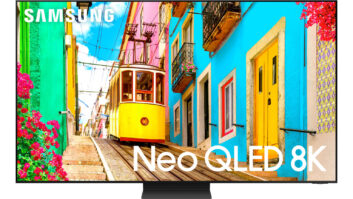LAS VEGAS —
The new and improved 3D TV system
hardly started out as the revolution some manufacturers
and content producers made it sound like during last
spring’s star-studded launch events and viewing parties.
In fact, set adoption amounted to little more than a blip
on the radar screen in the overall HDTV mix last year. According
to TV market analyst Tamaryn Pratt, of Quixel Research,
full 3D TV system sales (TVs including emitters
and glasses out of the box) were expected to register less
than 1 million units in the U.S. since the launch of the first
sets last March.
The results weren’t exactly disastrous for the launch of a
new advanced TV system — it just didn’t deliver the cure to
the recessionary blues most retailers have been desperate
to kick since 2008.
Instead of feature-packed 3D TVs, a large percentage
of shoppers opted for the barest of bones 2D models
with 720p resolution, blowout prices and thin dealer
margins.
Despite more pessimistic reports of 3D TV sales performances
during 2010, John Revie, Samsung home entertainment
senior VP, said his company is projecting U.S.
sales of 2 million 3D TV units in the 2010, and expects
that number to climb to as high as 6 million units in 2011
as the technology spreads into more TV model classes.
To help achieve that Samsung is spreading 3D capability
to some 80 percent of its 2011 flat-panel TV models.
Comparatively, Quixel Rearch is forecasting sales of approximately
3.8 million units in 2011, an assessment supported
by several other set makers.
“I’m not saying that it won’t grow tremendously more
if manufacturers add the capability more broadly across
their product mix,” Pratt said, “but there is still a lot of LCD
TV sold by lower-tier players, who won’t be including 3D
as aggressively as Samsung next year.”
Revie, whose company claims market share leadership
in the new technology, said that manufacturers and retailers
actually got a lot right in the rollout of 3D TV last year.
In 2011, the emphasis will be on further “educating consumers”
and getting them to see 3D movie demos while
optimizing the in-store experience to drive home the message
that “3D movies offer a more immersive experience.”
At the same time many manufacturers this year will be
re-emphasizing 3D TV as an HDTV feature rather than a
new TV category. Some industry observers believe the
new-category approach may have turned off or confused
potential customers still adjusting to the recent and massive
transition from analog to digital TV broadcasting.
The strategy here is that by making 3D a feature story
it can be added to more model lines, without leading
confused consumers into thinking the technology is only
compatible with 3D TV content. It also helps feed the Trojan
Horse effect of getting the capability into the hands
of purchasers that may not have cared about 3D, only to
embrace it after experiencing it in their own living rooms.
With such customers in mind, many manufacturers will
be offering lines of 3D TVs without the customary bundled
glasses, to reduce the upfront adoption cost this year.
Other than price, the biggest consumer turnoff to 3D,
according to numerous shopper surveys, was the need to
wear and purchase expensive 3D glasses.
Manufacturers including LG, Toshiba and Vizio, are addressing
that in 2011 by offering 3D TV lines based on
polarized “passive” glasses technology, offering generally
more comfortable glasses that are significantly cheaper,
and familiar to consumers who have worn them in 3D
movie theaters. In fact, the glasses many brought home
from those theaters can be used with the new sets — a
far cry from the $150 to $300 a pair price tags placed on
aftermarket active-shutter eyewear.
LG and Toshiba are positioning their passive-glasses
3D TVs as entry 3D, despite the anticipated added cost
the technology puts on the TV side of the equation.
Both companies continue to offer active-shutter 3D
sets in their highest end lines, where brighter pictures and
faster frame rates are generally required.
LG also will use only active-shutter glasses (this year
with more robust RF instead of IR linking) in its 2011 3D
plasma lines, because plasma technology was not considered
bright enough to support the dimming effect the
glasses introduce, according to Tim Alessi, LG home entertainment
product management director.
Both LG and Samsung will also offer 720p active-shutter
3D plasma models next year at less than $1,000 price
points as added-value alternatives.
Sony, like many manufacturers, is looking to expanded
active-shutter 3D into the LED/LCD TV category. Some
16 models will have 3D LED capability in screen sizes
ranging from 32 to 65 inches this year, Sony said, as it
plans to push combined 3D and connected TV systems
models in ultra-thin monolithic design cabinets.
Makers or LED models are looking to shore up their offerings
as 3D plasma has gained back some lost ground:
purchasers of 3D TV in 2010 gravitated to a greater degree
toward plasma models with the capability, after perceiving
the effect to be superior in the active-shutter viewing
environment, Pratt observed.
According to Samsung’s estimates, U.S.
plasma sales enjoyed between a 10 and 15
percent increase in units year over year to close
to 4 million. While some growth came from 3D
models, Revie said the majority of the business
actually came from lesser featured 1080p and
720p models that gave shoppers a strong value
during the tight economy.
Average prices trended 10 percent or lower
below comparably configured LED LCD TVs,
said Revie.
Most analysts, manufacturers and retailers
also agree that the launch of 3D was hampered
in 2010 by the perceived lack of available 3D
content. Many of the biggest 3D Blu-ray Disc
titles were restricted to purchasers of select
TV brands that had pre-arranged bundling exclusives
on titles with studios to help defray
studios’ risks and disc production costs while
helping to hype manufacturer-specific TV lines.
While title bundling will likely continue this year,
the library of openly available 3D Blu-ray movies
grew by the end of 2010 to more than 24, with
many more scheduled for release in the year ahead.
Meanwhile, 3D content has also spread to
specialized channels on more cable and satellite
TV platforms, showing key events, movies
and programs in 3D, while Samsung has added
a 3D movie trailer app to stream content from
the Internet.
New 3D content availability is scheduled to
intensify in 2011, observers said.













